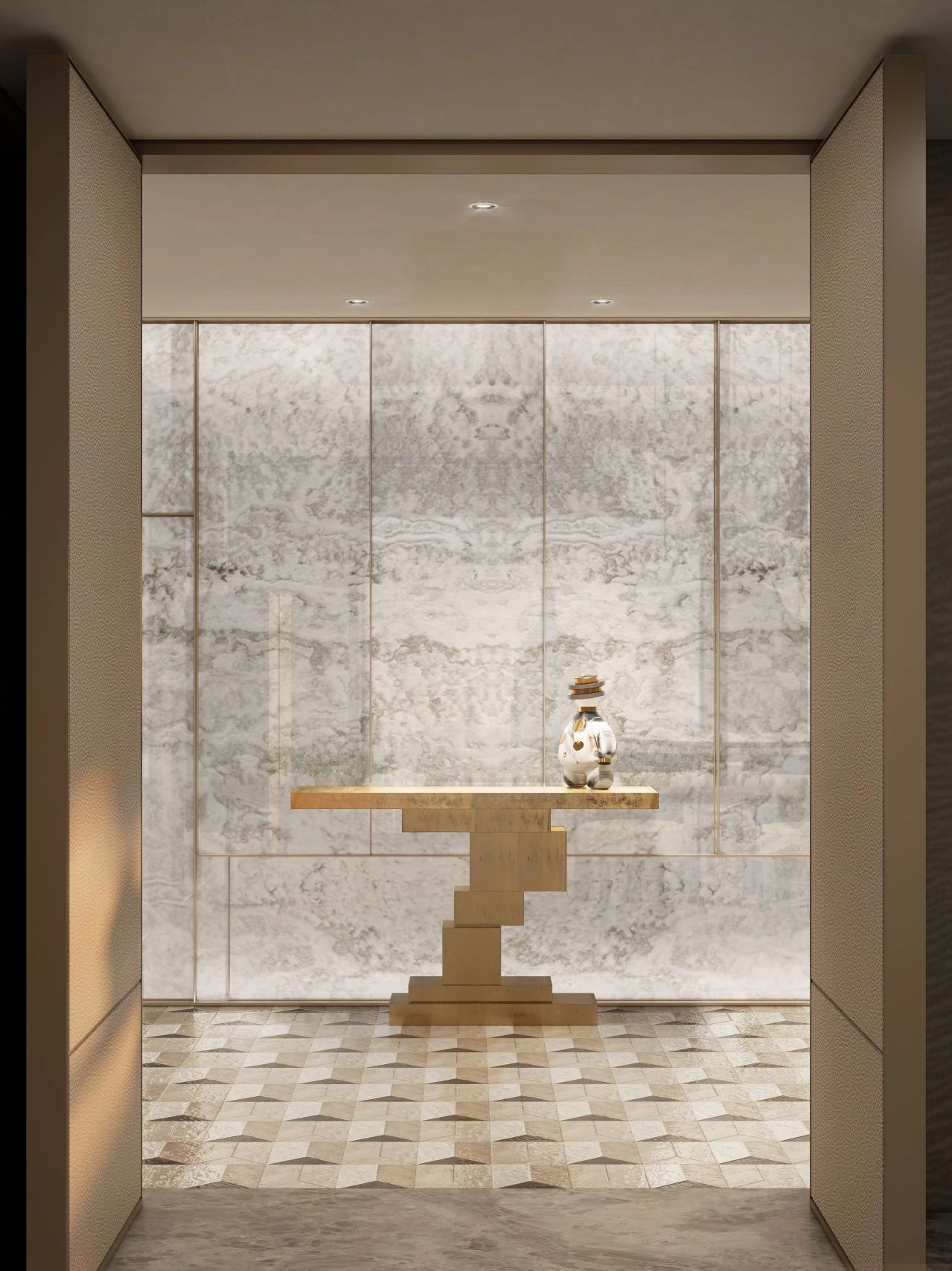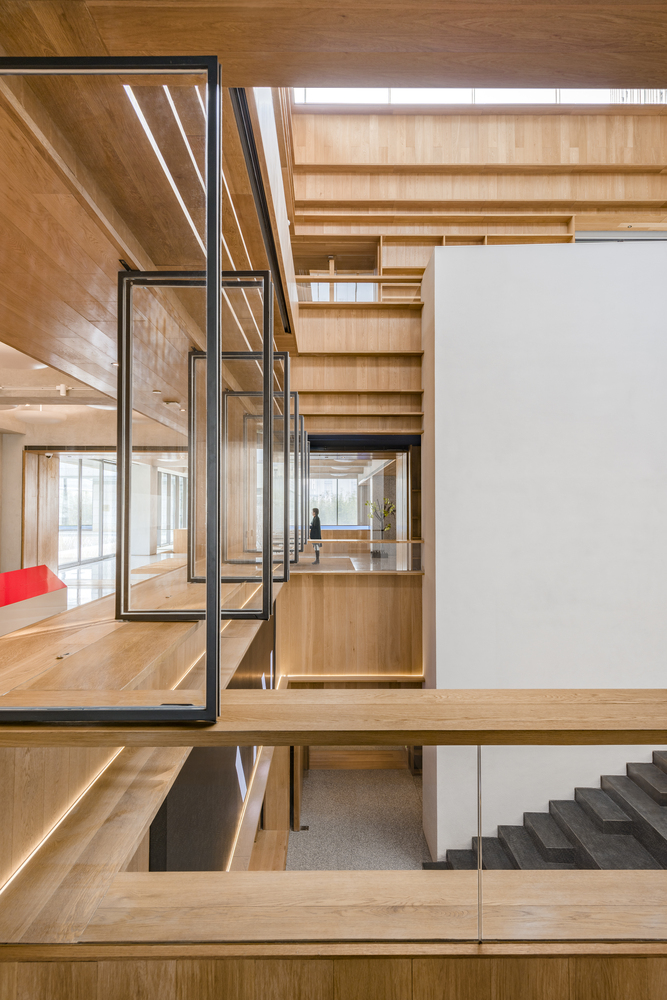Villa B Tectoniques Architects
2013-11-11 01:00
架构师提供的文本描述。这个计划效率很高,几乎是正方形,大小为10×11米。在一楼的西面有一个修车厂,修整成黑色的三棱木复合材料,由一个树冠延伸而成。免费和开放,它是围绕一个中心核心,其中包括服务:地窖,网络,淋浴/浴室,和厨房。所有的房间都围绕着这个中心形成了一个环。通过视图不间断地保持与自然的持续接触,使用滑动隔断和大面积的釉面相互面对。一条附属和储存区沿西墙的全部高度延伸。总体规划创造了一个多用途的空间,向南、北花园和露台开放。建筑物与外部空间之间产生了一致性,从而增强了彼此之间的一致性。这样,居住面积就比墙壁划定的空间更大。
Text description provided by the architects. The plan is efficient, almost square, measuring 10 x 11m. Along the west of the ground floor is a garage finished in black pannels timber composite, extended by a canopy. Free and open, it is organised around a central core that contains the services: cellar, networks, shower/bath room, and kitchen. All the rooms form a ring around this hub. Uninterrupted through views and continual contact with nature are maintained by using sliding partitions and large glazed areas facing each other. A strip of ancillary and storage areas runs along the full height of the west wall. The overall scheme creates a multipurpose space, open onto the south and north gardens and the patios. Consistency is created between the building and the external spaces, which enhance each other. Thus the living area becomes larger than the space delimited by the walls.
© Erick Saillet
c.Erick Saillet


房子朝正南。主要是玻璃,它受益于太阳的增益,同时受到遮阳调节百叶窗的保护,以控制夏季、春季和秋季更强的阳光。向南和向东开放,其上一层在北部关闭,而西侧只有小开口供淋浴和浴室使用。由于当地的气候形成强烈的对比,热和冷的高峰,这一计划的布局允许最大限度地占用根据季节的庭院,避风遮挡。从长远来看,各种中间要素和周边元素可根据天气和季节的不同,如乔木、檐篷、龙骨等,增强现有的空间,并使空间发生变化。在上层,系统被颠倒了:布局组织从核心开始,打开到卧室。根据日间和夜间分开的原则,上层有四间卧室和两间浴室。卧室朝南和向东,浴室向西开放。除了明确确定的起居区外,这座房子还有中间和多用途的空间。这就是底层的情况,它的滑动隔板可以有几个布局;此外,一些没有预留用于任何特定用途的房间可以根据一天中的时间进行重新配置,例如书房-洗衣房-计算机房或客房-书房-音乐室。这种适应性是对管理家庭内部隐私和公共生活的需要的一种反应。
The house faces due south. Largely glazed, it benefits from solar gain, while being protected by brise-soleil adjustable louver sun breaks to control stronger sunshine in the summer, spring and autumn. Open onto the south and east, its upper floor is closed on the north, and the west side only has small openings for the showers and bathrooms. Since the local climate is strongly contrasted, with peaks of heat and cold, this plan layout allows maximum occupation of the patios according to the seasons, sheltered from the wind. In the long term, a variety of intermediate and peripheral elements may enhance the existing and vary the spaces, according to the weather and the seasons, such as arbours, canopies, pergolas, etc. On the upper floor, the system is reversed: the layout organisation starts from the core and opens onto the bedrooms. Following the principle of separation of daytime and night-time areas, the upper floor is occupied by four bedrooms and two bathrooms. The bedrooms face south and east, while the bathrooms open to the west. In addition to the clearly-identified living areas, the house has intermediate and multipurpose spaces. This is the case on the ground floor, which, with its sliding partitions, can have several layouts; also, some rooms that are not set aside for any specific purpose can be reconfigured according to the time of day, e.g., study-laundry-computer room or guest bedroom-study-music room. This adaptability is a response to the need to manage both privacy and communal life within the family home.
© Erick Saillet
c.Erick Saillet


建筑很简单。这是一座木结构房屋,建在混凝土板上,上面铺着混凝土顶盖。该结构是一个预制的模块化系统。屋面保温由40 cm厚的膨化纤维素垫组成,墙外保温由矿物棉和木棉组成,总厚度为32 cm。木棉以滞后效应减缓了房屋的升温和冷却速度。在一楼,三个大的三层玻璃面板-一个固定的部分和一个平移(倾斜)开口机-运行沿海拔在天花板高度和框架景观。它们避免通过门框和窗框来打断视线,并将目光吸引到外面。在楼上,在卧室里,低倾斜和旋转的窗户有一个固定的窗户-床高的胸部。在立面上,将穿孔落叶松包层固定在双5x5cm壁板上,以进一步提高通风效果。熔覆层自然灰白,不经任何处理,呈均匀的银光。在里面,一个无结,浅色极板的衬里使用非常均匀的内置橱柜,家具和储存元件。在其他地方,白色石膏板为房子增添了柔和明亮的气氛。
The construction is simple. It is a timber-framed house, erected on a concrete slab, with a concrete topping laid on the upper floor. The structure is a prefabricated modular system. The roof insulation consists of 40 cm thick expanded cellulose wadding, and the wall insulation consists of mineral wool with woodwool on the outside, giving a total thickness of 32 cm. The woodwool slows down warming and cooling of the house by a lagging effect. On the ground floor, three large triple-glazed panels – with a fixed part and a translating (tilting) opener – run along the elevation at ceiling height and frame the landscape. They avoid interrupting the views by door and window frames, and they draw the eyes towards the outside. On the upper floor, in the bedrooms, low tilt-and-turn windows have a fixed window-breast at bed height. On the facades, perforated larch cladding is fixed to double 5 x 5 cm wall plates to further increase the ventilation effect. The cladding gradually greys naturally, without any treatment, with uniform silvery tinges. Inside, a lining of knot-free, light-coloured polar panels is used with great uniformity for built-in cupboards, furniture and storage elements. Elsewhere, white plasterboard adds to the soft, brightly-lit atmosphere of the house.
© Erick Saillet
c.Erick Saillet


空间采暖主要由底层地板采暖和上层地板采暖提供。它由冷凝气体锅炉和太阳能电池板提供。双流通风系统与位于房屋以北2.00至2.50米深度的糖化地面空气换热器相连,在12°C的恒温下提供空气,必要时,该换热器可在夜间提供额外的通风。在冷峰期间,木材燃烧炉满足额外的加热需求,计算出的总体积和瞬间,特别是上层地板。蜡混凝土和地板采暖提供了非常愉快的热舒适。混凝土顶盖,尽管木材结构选择,提供了地板在底层和上层,在卧室,淋浴和浴室的统一。此外,屋顶还种植了一层石榴盖,雨水被收集在地下储罐中。所有这些系统都需要一些控制才能尽可能地发挥作用。这是一个技术问题,需要一定程度的掌握,这是经验性的,并要求占用者对他们感兴趣,并改变他们的习惯。
Space heating is mainly provided by floor heating on the ground floor and the upper floor. It is supplied by a condensation gas boiler and solar panels. The double-flow ventilation system is connected to a glycolated ground-air heat exchanger laid at a depth of between 2.00 and 2.50 m to the north of the house, which supplies air at a constant temperature of 12°C. When necessary, the exchanger can provide additional ventilation at night. During cold peaks, wood-burning stove covers additional heating needs, calculated for the overall volume and instantaneously, particularly for the upper floor. Waxed concrete and floor heating provide very pleasant thermal comfort. The concrete topping, which is chosen despite the timber structure, provides uniformity of floors on the ground floor and upper floor, in bedrooms, showers and bath rooms. In addition, the roof is planted with a sedum [stonecrap] covering, and rainwater is collected in an underground tank. All of these systems require some control to function as well as possible. This is a technical matter that needs a certain degree of mastery, which is acquired empirically and requires the occupants to take an interest in them and to change their habits.


























Architects Tectoniques Architects
Location Lyon, France
Category Houses
Area 204.0 sqm
Project Year 2013
Photographs Erick Saillet
























